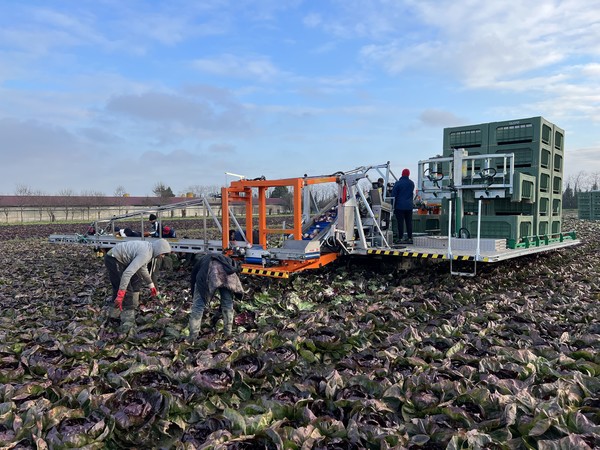
The whitening of greens and vegetables
This technique, in addition to light color, gives vegetable species a crisp texture and delicate taste, which increases consumer liking. Different solutions are adopted for the purpose, also in relation to the peculiar characteristics of individual products
Large-scale distribution has made consumers accustomed to buying fruits and vegetables cleaned and laid out on display on store counters, but they often do not think about, or even know, the amount of work that has gone into preparing the products. Some of these - greens and vegetables in particular - are subjected to processes that are beyond the pure production chain, sometimes even performed postharvest. For the most profitable crops, whitening is one of the most frequently adopted operations, requiring much energy and considerable care.
Whitening
Basically, it involves limiting the exposure of the crop to light in order to achieve a reduction in chlorophyll levels in the plant material. As the name suggests, the most noticeable effect of whitening is the change to much lighter, if not almost white, tones of the classic green (or red, depending on the variety) color of various crops. Among other things, the reduction in chlorophyll concentration generally makes the product "sweeter" on the palate, a feature extremely appreciated because of the absence of the classic bitter aftertaste. A secondary effect, equally appreciated by consumers, is the change in texture: In fact, lack of exposure to light (during development and/or as post-treatment in specially identified locations) causes plant tissues to be crispy and much less fibrous than the same production obtained in full light. Basically, it is like interrupting the growth of the crop: by depriving it of solar radiation, the plant is forced to breathe instead of photosynthesizing. This results in a negative energy balance, which is supported by the degradation of the starch accumulated by the plant into sugars, consequently making the product sweeter on the palate. Several ways of whitening have been developed: the most common are tying, tamping, mulching and tunnel/cell.
Whitening in the field
This is a widely used practice for many crops, such as fennel, endive escarole, white asparagus, etc., which involves limiting exposure to light in the field as early as the growing stage. Among the various methods applied is tamping, often adopted for fennel. In this case, whitening is forced on the edible shoot (i.e., the edible part, known as the "grain"), which, in order to remain white and not fibrous (otherwise, it would become green and fibrous like the leaves), is covered with soil by tamping. In the case of hypogean crops, such as white asparagus, whitening is accomplished by covering the beds with mulching cloths, which prevents the shoots emerging from the soil from photosynthesizing, changing the color to green or purple. A variant of mulching is applied to thistle and celery, in which the epigeal part of the plant is wrapped with black breathable tarpaulins that shield it from light.
The opposite is the case with head salads, foremost among them endive escarole. The plant has an open-headed habit, and to whiten its heart, action is taken by binding the outermost leaves of the head itself so as to obtain even more tender and sweet material. The outer leaves will remain active in terms of photosynthesis and will become more leathery and bitter.
Cell/tunnel whitening
This procedure is performed in postharvest, typically applied to chicory and endives (e.g., Belgian endive), to leave the plants at low temperature and low (or no) light to achieve whitening. Often, "sand beds" are set up to vertically house the heads, which must remain in a water deficit for two to six weeks, at the end of which time the withered and diseased outer leaves are removed.
One of the major problems of this method is rot and mold development if plants are stored with moist leaves. This problem can degenerate to the point where the entire crop is compromised.
The fennel production chain
The edible part of fennel is the heart, or basal part of the leaves, characterized by delicate taste and white color. Like many other hypogeal crops, fennel fears waterlogging, so it is necessary to ensure soft, well-drained soil. The planting size is 50-70 cm between rows and 20-30 cm in the row, with a transplanting depth of no more than 30-40 cm. In order to ensure whitening, tamping is carried out about 20 days before harvest.
Harvesting and subsequent crop cleaning can be done manually by scaling the plants (e.g., using a spade) and then removing the waste. Alternatively, mechanized harvesting involves handlers who undermine, pick up and cleanse the produce through two counter-rotating conical rollers that dig into the sides of the row, "milking" the plants, which are then cut off at the foot. A rotating roller conveyor system grabs the clump to transport the plants to the back of the machine, where two counter-rotating blades separate the leaves from the edible part, which is finally delivered via a conveyor belt into the boxes.
The radicchio chicory production chain
Radicchio is offered on the market in wide morphologically different varieties, but they all share part of the production chain. It is an herbaceous plant with spacing on the row varying between 25 and 40 cm. Again, soft, well-drained soils are required to ward off rot and waterlogging. Harvesting can be done by hand uprooting individual plants and severing the rhizome to a depth of about 5 cm.
Alternatively, mechanical harvesting involves towed or self-propelled equipment with different functioning. One type of machinery takes advantage of a pair of counter-rotating rollers placed on either side of the row to orient the heads, which are then cut at the foot by two circular blades and conveyed via conveyor belts into the storage crates. The second is similar to leaf salad harvesters. It consists of a double oscillating blade cutting bar that cuts the head just below the soil surface, to be then transferred into the boxes.
For whitening, plants are arranged vertically in boxes and laid in special darkened and ventilated tunnels or cells, with a moist bottom (wet sand) or a veil of water to ensure proper plant moisture. In this "protected" environment, the produce is left for at least two weeks, after which the heads are stripped of their diseased outer leaves, then washed and dried for marketing.
The whitening of endive with domes
In France, as an alternative to tying, the whitening of endives and salad greens in the field is sometimes carried out by implementing plastic domes that reduce the decay of the outer leaves.
This solution was also adopted for a brief period in Italy but, due to considerable weather variability, it was not successful, since in addition to the instability of the canopy because of wind, it carried a significant risk of leaf rot.
Italian varieties of radicchio chicory
The radicchio chicory is an extremely popular crop in Italy; cultivated varieties differ substantially in leaf color, ranging from pure white to variegated pink to the better-known red radicchio. The latter also differs in the appearance of the head: there is Chioggia radicchio with a globular appearance, the more elongated Verona radicchio, to the decidedly long Treviso radicchio (early or late), known and appreciated for its firm, crisp leaves.








